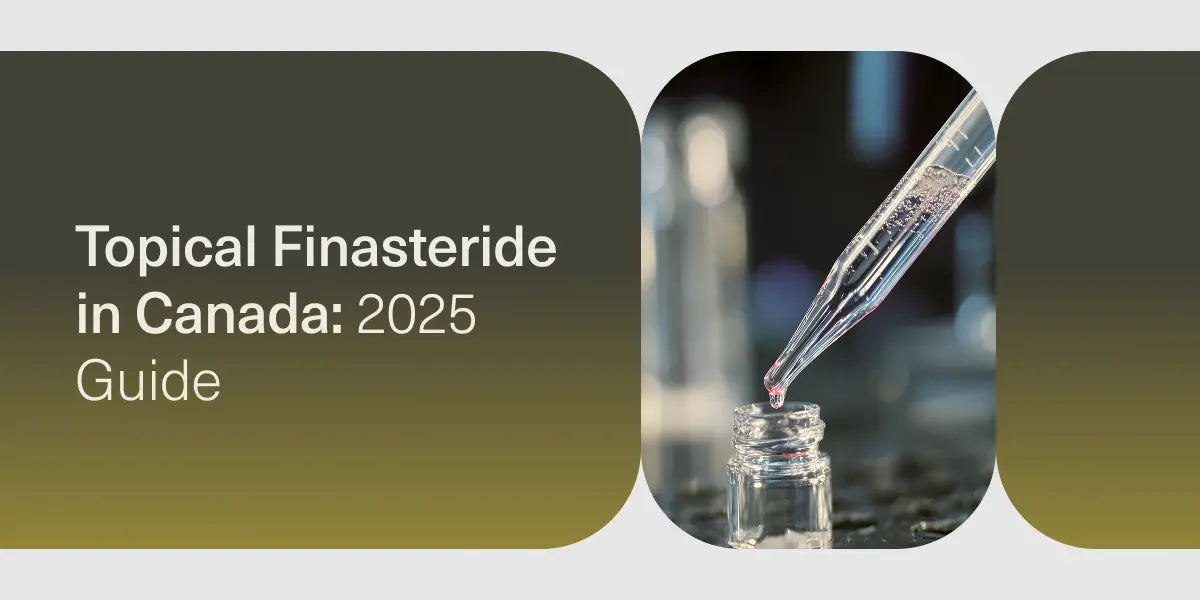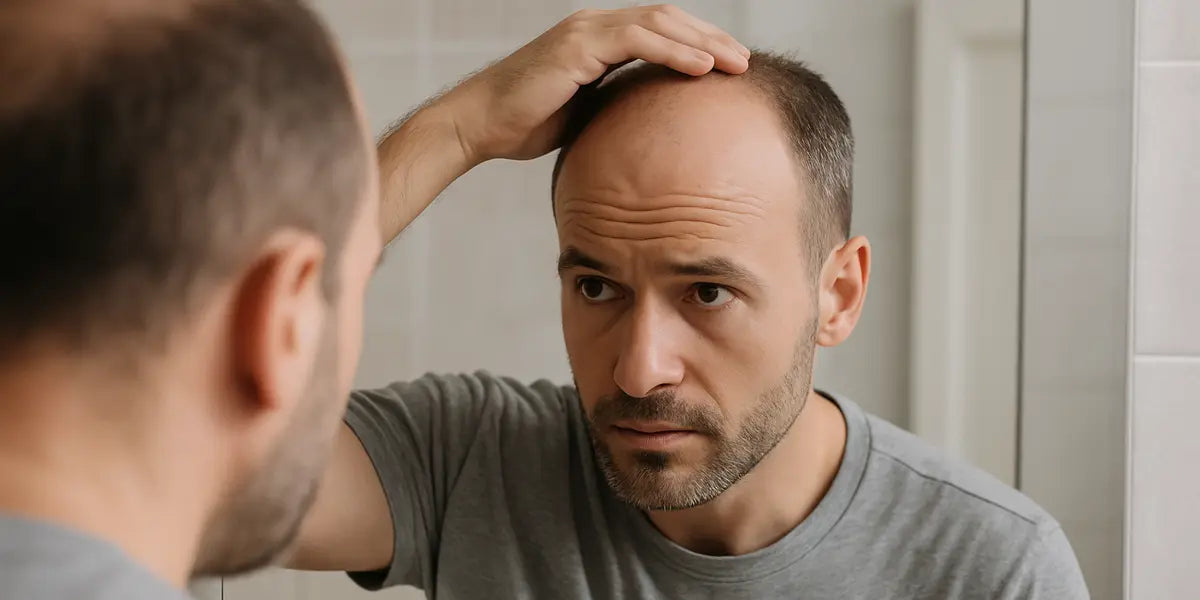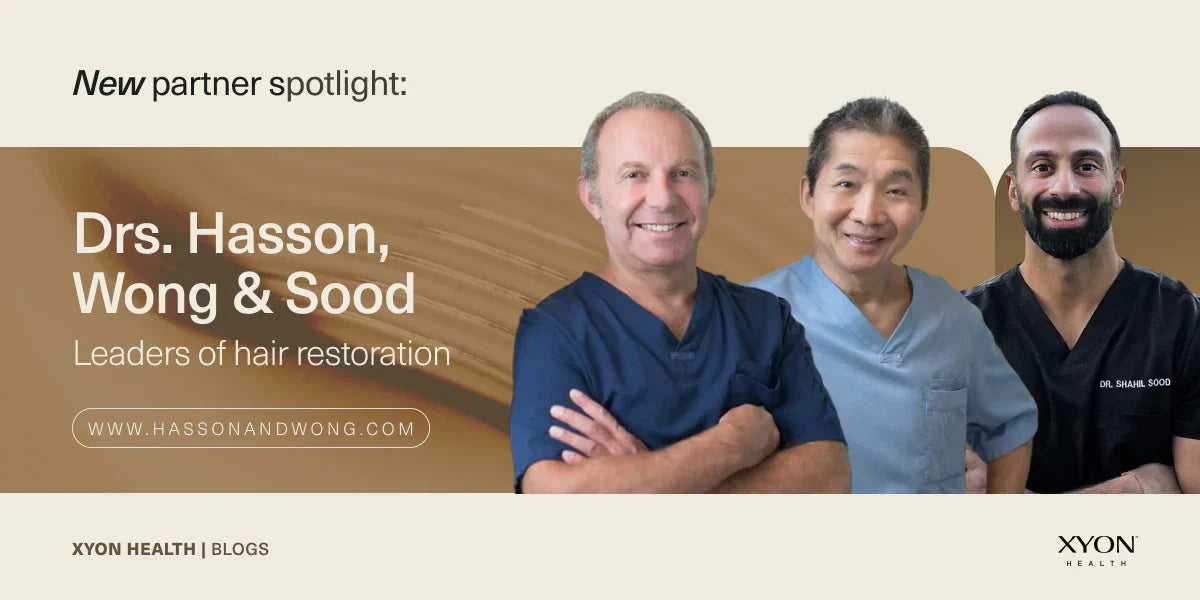Finasteride has been the gold standard for treating male pattern hair loss for over two decades.
A new compounded formulation of topical finasteride (in SiloxysSystem™ gel) offers Canadians finasteride in a skin-targeted topical form, designed to lower finasteride levels in the body with the goal of reducing the risk of side effects.
This complete 2025 guide explains what topical finasteride is, how it works, what clinical studies show, and what Canadians should know before using it.
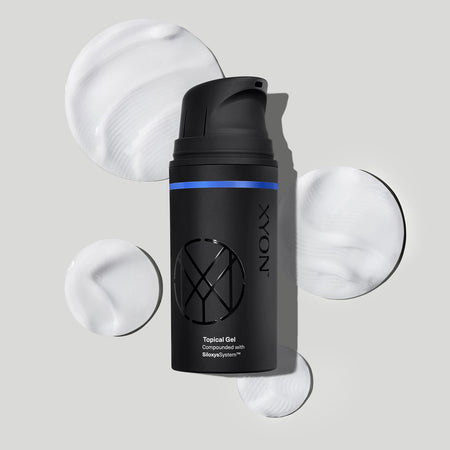
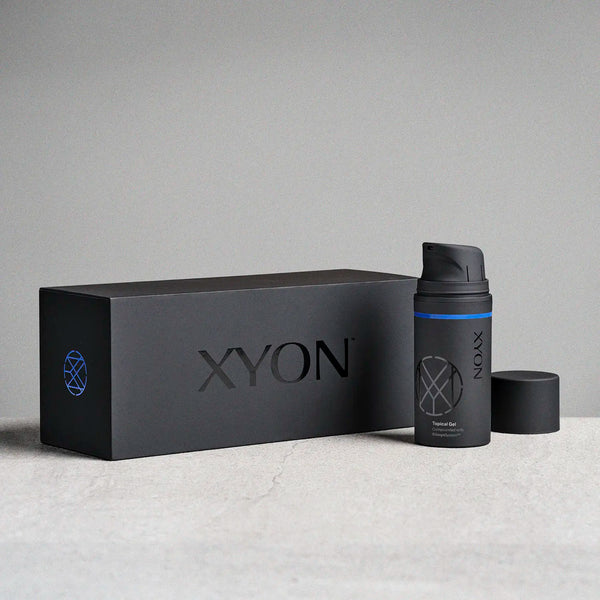
A patented delivery system designed to deliver the best results.
Experience SiloxysSystem™ Gel. It's topical hair loss treatment, elevated.
What Is Finasteride?
Finasteride is a 5-alpha reductase inhibitor, originally developed in a 5 mg dose to treat benign prostatic hyperplasia (BPH) and later approved at a lower dose of 1 mg for the treatment of androgenetic alopecia.
By inhibiting the enzyme that converts testosterone into dihydrotestosterone (DHT), finasteride reduces the hormone responsible for follicle shrinkage and progressive hair loss. This helps keep hair in the growth (anagen) phase for longer.
Finasteride is very effective, with:
Stopping further hair loss in over 80% of men, and
-
Two-thirds of men experiencing visible hair regrowth (Mella JM et al., Arch Dermatol, 2010; PubMed ID: 20956623).
Oral finasteride works systemically, but that systemic activity is also what concerns some users. “Systemic” means the medication is absorbed and enters your bloodstream to reach the scalp hair follicles. Because of concerns about systemic effects, there has been increased interest among patients and doctors in topical finasteride, particularly formulations that may truly limit systemic absorption.
What Is Topical Finasteride (and How Is It Different)?
Topical finasteride has the same active ingredient as oral finasteride, but in a delivery system applied directly to the scalp as a gel, foam, or liquid solution. Because not all topicals have the same absorption kinetics, the type of topical formulation may offer different efficacy results and side-effect profiles.
The purpose of topical delivery is to target DHT locally at the hair follicle—delivering more of the medication to the follicles with as little finasteride as possible entering the systemic circulation (the bloodstream).
In simpler terms, topical finasteride:
-
Has the same mechanism. It blocks DHT.
-
Acts via a different route. It works mainly on the scalp.
-
May reduce systemic exposure. Some formulations show reduced absorption into the bloodstream, which can mean potentially fewer side effects.
How Topical Finasteride Works on Hair Follicles
Hair loss from androgenetic alopecia (AGA) is caused by DHT binding to androgen receptors in genetically sensitive hair follicles. Over time, due to DHT exposure, these follicles shrink (miniaturize), producing thinner and shorter hairs.
Topical finasteride interrupts this process at the root level by:
-
Blocking local 5-alpha reductase activity in the scalp.
-
Reducing DHT concentration in follicular tissue.
-
Prolonging the anagen (growth) phase, improving hair density and thickness.
By applying the medication locally to the scalp, topical finasteride is intended to minimize the possibility of side effects that come from systemic absorption.
Clinical Evidence: What PubMed Studies Show
Peer-reviewed studies indexed on PubMed websites (free database of biomedical literature) provide the key sources researchers and clinicians use when referencing and prescribing finasteride. These clinical studies are the best source for understanding the intricacies of how topical finasteride works.
1. Topical Finasteride Effectively Lowers Scalp DHT
Caserini M. et al., 2014. Int J Clin Pharmacol Ther. 52(10):842–849. PMID: 25074865
0.25% topical solution reduced scalp DHT by 68–75%, with only 11–15% reduction in serum DHT, consistent with targeted local action.
2. Proven Local Efficacy, Minimal Systemic Absorption
Caserini M. et al., 2016. Int J Clin Pharmacol Ther. 54(1):19–27. PMID: 26636418
Demonstrated equivalent scalp DHT suppression to oral finasteride, with a significant reduction in systemic exposure.
3. Comparable Hair Regrowth to Oral Finasteride
Mazzarella G.F. et al., 1997. J Dermatol Treat. 8(3):189–192. PMID: 9595611
Both oral and topical finasteride groups showed visible regrowth after 16 months, with the topical group reporting fewer adverse effects.
4. Finasteride + Minoxidil = Superior Outcomes
Tanglertsampan C., 2012. J Med Assoc Thai. 95(10):1312–1316. PMID: 23193746
A combination of 0.1% finasteride + 3% minoxidil achieved greater regrowth and satisfaction than topical minoxidil alone.
5. Systematic Review: Comparable Results, Fewer Side Effects
Lee S.W. et al., 2018. J Drugs Dermatol. 17(4):457–463. PMID: 29601622
“Topical finasteride demonstrates efficacy similar to oral administration with significantly reduced systemic exposure.”
Topical vs. Oral Finasteride: Evidence-Based Comparison
| Factor | Oral Finasteride | Topical Finasteride |
|---|---|---|
| Mechanism | Inhibits 5-alpha reductase systemically | Inhibits 5-alpha reductase locally |
| DHT Reduction (Scalp) | ~70% | ~70% |
| DHT Reduction (Serum) | ~60–70% | 15% |
| Sexual Side Effects | 2–8% incidence | 1% incidence (limited data) |
| Typical Use | 1 mg daily tablet | 0.25% topical solution or gel |
| Regulatory Status (Canada) | Prescription required | Prescription + compounded (made in the pharmacy) |
Safety, Tolerability, and Side Effects
Scalp / Skin Reactions
-
Mild redness, dryness, or itching
-
Temporary shedding during early phases
Systemic Side Effects
Sexual side effects such as decreased libido and erectile dysfunction have been reported with finasteride. Topical finasteride does pose some risk but is reported less frequently than with oral formulations, which have higher systemic absorption.
Handling Warning
Finasteride can cause abnormalities in a developing male fetus. Women who are pregnant or may become pregnant must not handle or touch finasteride medications. Partners should consult their clinician about finasteride use when trying to conceive and during pregnancy.
Long-Term Safety
Safety Snapshot (up to 16 months)
Studies up to 16 months show limited significant systemic hormonal disruption from topical finasteride application (Mazzarella 1997; Caserini 2016).
Results Timeline
| Timeline | What to Expect |
|---|---|
| 0–3 months | Possible shedding as new hair cycles begin. |
| 3–6 months | Reduction in hair loss; early regrowth. |
| 6–12 months | Noticeable thickening and increased density. |
| 12+ months | Sustained growth; near-maximal improvement. |
Consistency matters: stopping treatment allows DHT to rebound and hair loss to recur.
Topical Finasteride in Canada: Prescription Rules
In Canada, all finasteride formulations are prescription-only under Health Canada regulations. Topical finasteride is not Health Canada–approved; it is compounded by licensed pharmacies only when prescribed by a physician for situations where Health Canada–approved options (oral finasteride or topical minoxidil) are not deemed clinically indicated.
- You can only purchase topical finasteride with a prescription.
- A healthcare provider must evaluate your suitability and determine the appropriate dose and formulation.
- Compounded medications are prescribed for individual patients and dispensed through regulated pharmacies.
Who Benefits Most from Topical Finasteride
- Men with androgenetic alopecia (pattern hair loss).
- Individuals who experienced side effects on oral finasteride.
- Those who prefer localized treatment.
- Patients who have tried Health Canada–approved treatments (oral finasteride, topical minoxidil) without optimal improvement.
Formulations may also be considered in select women under strict physician supervision (e.g., post-menopausal).
How Do I Get Topical Finasteride in Canada?
Getting topical finasteride in Canada is easy, all you need to do it obtain a prescription from a licensed healthcare provider since it's not available over-the-counter. Topical finasteride is not a commercially manufactured drug in Canada (unlike the oral tablet), it's typically prescribed "off-label" and custom-made by a compounding pharmacy. Canadians can use a telehealth platform where you complete an online medical assessment. If deemed suitable, a licensed practitioner will issue a prescription, and the compounding pharmacy will ship the medication directly to your door. Which provider you select will depend on your own evaluation of the available options, which XYON offering the most medication in a topical on the market.
How to Use It Correctly
- Apply as prescribed by your doctor, generally once daily to a clean, dry scalp.
- Use the exact dose specified by your prescriber; don’t self-adjust.
- Massage gently into areas of thinning.
- Wash hands thoroughly after application.
- Let hair fully dry before styling or lying down.
Avoid combining topical finasteride with other topicals or oral finasteride unless your prescriber directs you to.
Expected Outcomes: What the Data Says
- Scalp DHT reduction: ~60–75%
- Average hair density increase: ~15–25% over 6–12 months
(Derived from Caserini 2014; Lee 2018; Tanglertsampan 2012.)
Across multiple peer-reviewed studies, topical finasteride can match oral efficacy with a lower risk of systemic side effects.
Frequently Asked Questions
Is topical finasteride legal in Canada?
Yes, while not Health Canada–approved, it is legal when prescribed by a licensed Canadian physician and compounded by a regulated pharmacy (off-label use).
Do I need a prescription?
Yes. Finasteride is a prescription drug in Canada and is not available over-the-counter.
Can I combine it with minoxidil?
Evidence supports finasteride + minoxidil outperforming either alone. Combination use requires a prescription and is off-label in specific clinical contexts.
Are results permanent?
Results can be maintained with continued use. Discontinuation generally leads to reversal within 6–12 months.
Does it work for women?
May be considered off-label in post-menopausal women under medical supervision.
Clinical Reference Summary
| Study | PubMed ID | Key Finding |
|---|---|---|
| Caserini 2014 | 25195664 | 0.25% topical reduces scalp DHT ~70%; serum DHT <15%. |
| Caserini 2016 | 26636418 | Strong local suppression; minimal systemic impact. |
| Mazzarella 1997 | 9595611 | Topical ≈ oral efficacy; fewer adverse events. |
| Tanglertsampan 2012 | 23072276 | Finasteride + minoxidil > minoxidil alone (RDB trial). |
| Lee 2018 | 29676952 | Systematic review: topical ≈ oral efficacy; safer profile. |
| Mella 2010 (oral) | 20956649 | Oral finasteride: >80% hair retention. |
Key Takeaway
Topical finasteride can be a credible alternative to oral finasteride for Canadians concerned about systemic side effects. Peer-reviewed studies have shown:
- Comparable clinical efficacy to oral finasteride.
- Significantly less systemic DHT suppression with topical use.
- A strong safety profile under medical supervision.
Additional Clinical References
Caserini, M., Radicioni, M., Leuratti, C., Annoni, O., & Palmieri, R. (2014). A novel finasteride 0.25% topical solution for androgenetic alopecia: Pharmacokinetics and effects on plasma androgen levels in healthy male volunteers. International Journal of Clinical Pharmacology and Therapeutics, 52(10), 842–849. https://www.dustri.com/article_response_page.html?artId=12533&doi=10.5414/CP202119&L=0
Caserini, M., Radicioni, M., Leuratti, C., Terragni, E., & Palmieri, R. (2016). Effects of a novel finasteride 0.25% topical solution on scalp and serum dihydrotestosterone in healthy men with androgenetic alopecia. International Journal of Clinical Pharmacology and Therapeutics, 54(1), 19–27. https://www.dustri.com/article_response_page.html?artId=13950&doi=10.5414/CP202467&L=0
Mazzarella, G. F., Loconsole, G., Cammisa, A., Mastrolonardo, M., & Vena, G. A. (1997). Topical finasteride in the treatment of androgenic alopecia: Preliminary evaluations after a 16-month therapy course. Journal of Dermatological Treatment, 8(3), 189–192. https://www.tandfonline.com/doi/abs/10.3109/09546639709160517
Tanglertsampan, C. (2012). Efficacy and safety of 3% minoxidil versus combined 3% minoxidil/0.1% finasteride in male pattern hair loss: A randomized, double-blind comparative study. Journal of the Medical Association of Thailand, 95(10), 1312–1316. https://pubmed.ncbi.nlm.nih.gov/23193746/
Lee, S. W., Juhasz, M., Mobasher, P., Ekelem, C., & Atanaskova Mesinkovska, N. (2018). A systematic review of topical finasteride in the treatment of androgenetic alopecia in men and women. Journal of Drugs in Dermatology, 17(4), 457–463. https://pubmed.ncbi.nlm.nih.gov/29601622/
Mella, J. M., Perret, M. C., Manzotti, M., Catalano, H. N., & Guyatt, G. (2010). Efficacy and safety of finasteride therapy for androgenetic alopecia: A systematic review. Archives of Dermatology, 146(10), 1141–1150. https://jamanetwork.com/journals/jamadermatology/article-abstract/422032

